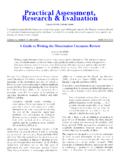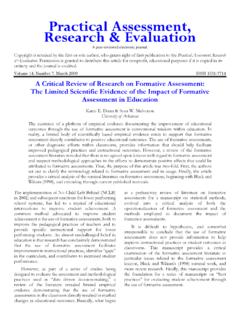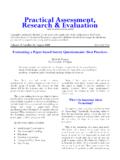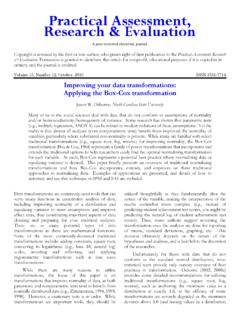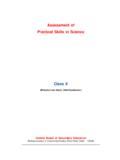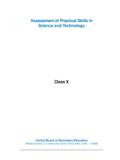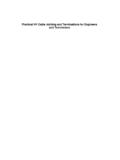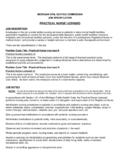Transcription of A peer-reviewed electronic journal. - pareonline.net
1 A peer-reviewed electronic journal. Copyright is retained by the first or sole author, who grants right of first publication to the practical Assessment, Research & Evaluation. Permission is granted to distribute this article for nonprofit, educational purposes if it is copied in its entirety and the journal is 11 Number 10, November 2006 ISSN 1531-7714 The Reliability, Validity, and Utility of Self-Assessment John A. Ross University of Toronto Despite widespread use of self-assessment, teachers have doubts about the value and accuracy of the technique. This article reviews research evidence on student self-assessment, finding that (1) self-assessment produces consistent results across items, tasks, and short time periods; (2) self-assessment provides information about student achievement that corresponds only in part to the information generated by teacher assessments; (3) self-assessment contributes to higher student achievement and improved behavior.
2 The central finding of this review is that (4) the strengths of self-assessment can be enhanced through training students how to assess their work and each of the weaknesses of the approach (including inflation of grades) can be reduced through teacher action. A large proportion of teachers (76% in Noonan & Duncan, 2005) reports using self-assessment at least part of the time, even though teachers express doubt about the value and accuracy of student self-appraisals. The doubts center on the concern that students may have inflated perceptions of their accomplishments and that they may be motivated by self-interest. Frequently heard is the claim that the good kids under-estimate their achievement while confused learners who do not know what successful performance requires, over-estimate their attainments. These concerns suggest, from a measurement perspective, that self-assessment introduces construct-irrelevant variance that threatens the validity of grading.
3 In this article I will examine research conducted on self-assessment for the purpose of addressing these practical questions posed by teachers: 1. Is self-assessment a reliable assessment technique? 2. Does self-assessment provide valid evidence about student performance? 3. Does self-assessment improve student performance? 4. Is self-assessment a useful student assessment technique? Definitions For the purpose of this article, I will follow Klenowski s (1995) definition of self-assessment as the evaluation or judgment of the worth of one s performance and the identification of one s strengths and weaknesses with a view to improving one s learning outcomes (p. 146). This definition emphasizes the ameliorative potential of self- practical Assessment Research & Evaluation, Vol 11, No 10 2 Ross, Self-Assessment assessment and focuses attention on its consequential validity.
4 Although some of the research conducted on self-assessment has consisted of students appraising their work with little interpretative guidance, I will argue with Klenowski that the benefits of self-assessment are more likely to accrue when three conditions are met: teacher and students negotiate self-assessment criteria, teacher-student dialogue focuses on evidence for judgments, and self-assessments contribute to a grade (by students alone or in collaboration with teachers). Although self-assessment has long been part of the repertoire of classroom teachers, assessment reform has increased its use. Key proponents of assessment reform ( ,Wiggins, 1993) recommend that students submit a self-assessment with every major assignment. Self-assessment is a valid instance of assessment reform (as defined by Aschbacher, 1991; Newman, 1997; Wiggins, 1993;1998) in that (i) students create something that requires higher level thinking ( , they interpret their performance using overt criteria); (ii) the task requires disciplined inquiry, ( , the criteria for appraisal are derived from a specific discipline); (iii) the assessment is transparent ( , procedures, criteria and standards are public); and (iv) the student has opportunities for feedback and revision during the task ( , by responding to discrepancies between the student s and teacher s judgment).
5 Other important features of assessment reform, , the extent to which the task represents real world applications of school knowledge, characterize some but not all self-assessments. Some teachers find it helpful to distinguish between self evaluation (judgments that are used for grading) and self assessments (informal judgments about attainment) as suggested by Gregory, Cameron, and Davies (2000). Not everyone finds the distinction helpful; for example, the text on classroom assessment by McMillan (2004) uses the terms interchangeably. Throughout this article, I will use the term self-assessment to refer to both formative and summative data collections. The term self-assessment is also used in the metacognition literature to refer to the judgments an individual makes on the basis of self-knowledge (Bransford, Brown, & Cocking, 1999).
6 My review will focus on self-assessments conducted in classroom settings and will touch only briefly upon findings from lab investigations. For an extensive review of self-assessment in the context of metacognition, see Sundstrom (2005). Why Teachers Use Self-Assessment When asked why they include self-assessment in their student assessment repertoires, teachers give a variety of responses. (1) Most frequently heard is the claim that involving students in the assessment of their work, especially giving them opportunities to contribute to the criteria on which that work will be judged, increases student engagement in assessment tasks. (2) Closely related is the argument that self-assessment contributes to variety in assessment methods, a key factor in maintaining student interest and attention.
7 (3) Other teachers argue that self-assessment has distinctive features that warrant its use. For example, self-assessment provides information that is not easily determined, such as how much effort students expended in preparing for the task. (4) Some teachers argue that self-assessment is a more cost-effective than other techniques. (5) Still others argue that students learn more when they know that they will share responsibility for the assessment of what they have learned. practical Questions Addressed by Researchers Is self-assessment a reliable assessment technique? Reliability, meaning the consistency of the scores produced by a measurement tool, can be determined in many ways. The internal consistency of self-assessments is typically high. For example, J. Ross, Rolheiser and Hogaboam-Gray (2002-b) had grade 5-6 students rate their performance on a 1-10 scale for each of five dimensions of mathematical problem solving.
8 The internal consistency was .91. Similar results were obtained for grade 4-6 self-assessments in English (alpha=.84 in J. Ross, Rolheiser and Hogaboam-Gray, 1999). There is also evidence of consistency across tasks. Fitzgerald, Gruppen, and White (2000) examined the self- practical Assessment Research & Evaluation, Vol 11, No 10 3 Ross, Self-Assessment assessments of medical students across two task formats: performance tasks (examination of standardized patients) and cognitive tasks (interpreting vignettes or test results). They found that students' self-assessments were consistent over a range of skills and tasks. Less frequently examined is consistency between one time period and another.
9 Blatchford (1997) found mixed evidence for long time periods. Blatchford reported that self-assessments were stable between ages 11 and 16 in mathematics, although not in English, a finding Blatchford attributed to feedback being less clear in English class than in mathematics. Blatchford found there was little agreement of self-assessments between ages 7 and 11 in either subject. There is greater reliability when the time periods are shorter. Sung, Chang, Chiou, and Hou (2005) had 14-15 year olds assess the quality of their web-designs on three occasions within a narrow time frame: after completing their designs, after viewing the designs of others in their own group and after viewing the best and worst designs in the class. Sung found no significant differences across occasions.
10 In summary, the evidence in support of the reliability of self-assessment is positive in terms of consistency across tasks, across items, and over short time periods. The studies showing adequate consistency involved students who had been trained in how to evaluate their work. There was less consistency over longer time periods, particularly involving younger children, and there were variations among subjects. Does self-assessment provide valid evidence about student performance? Validity in self-assessment typically means agreement with teacher judgments (considered to be the gold standard) or peer rankings (usually the mean of multiple judges which tend to be more accurate than the results from a single judge). Research on the self-assessments of university students produced mixed results.

